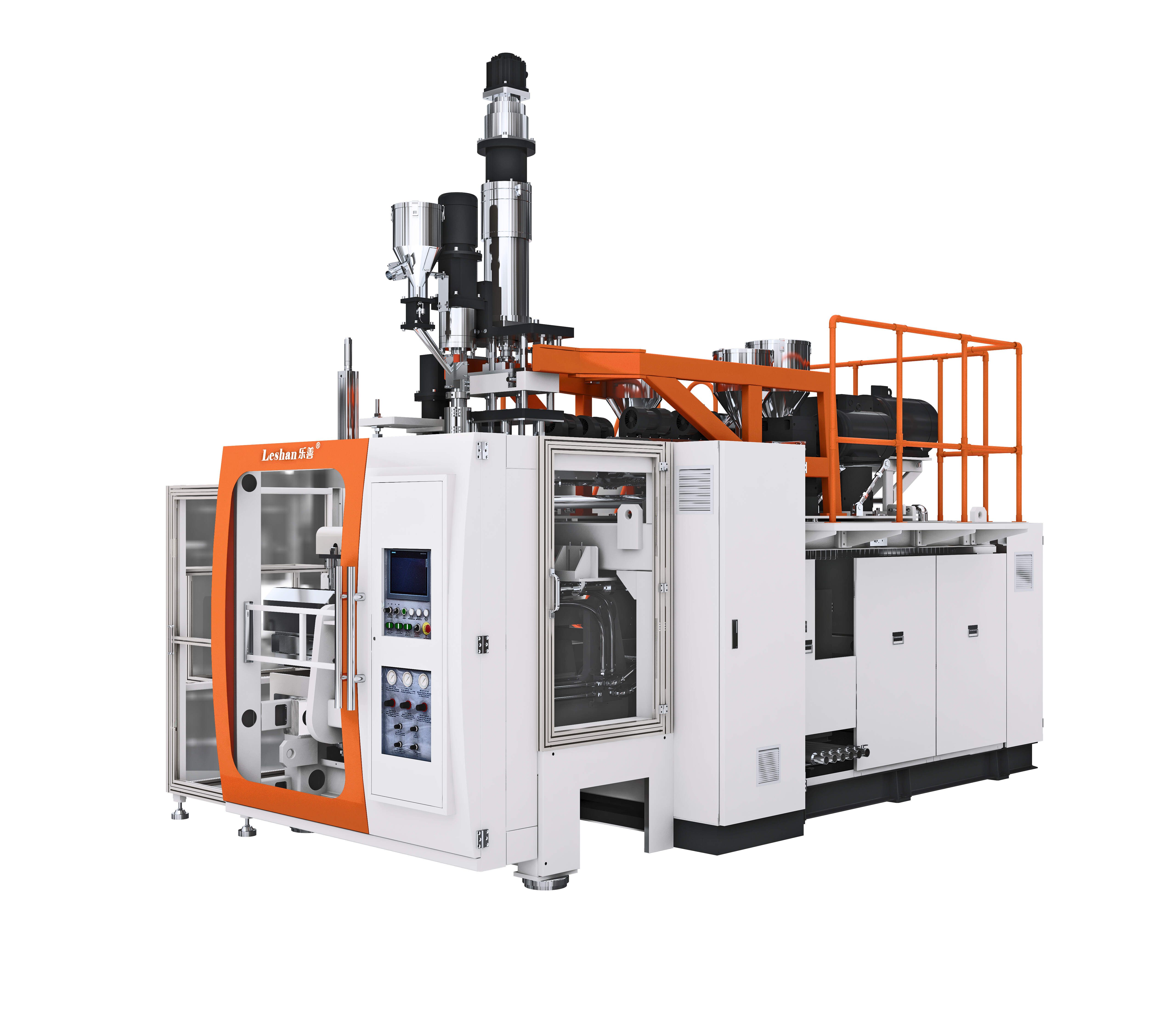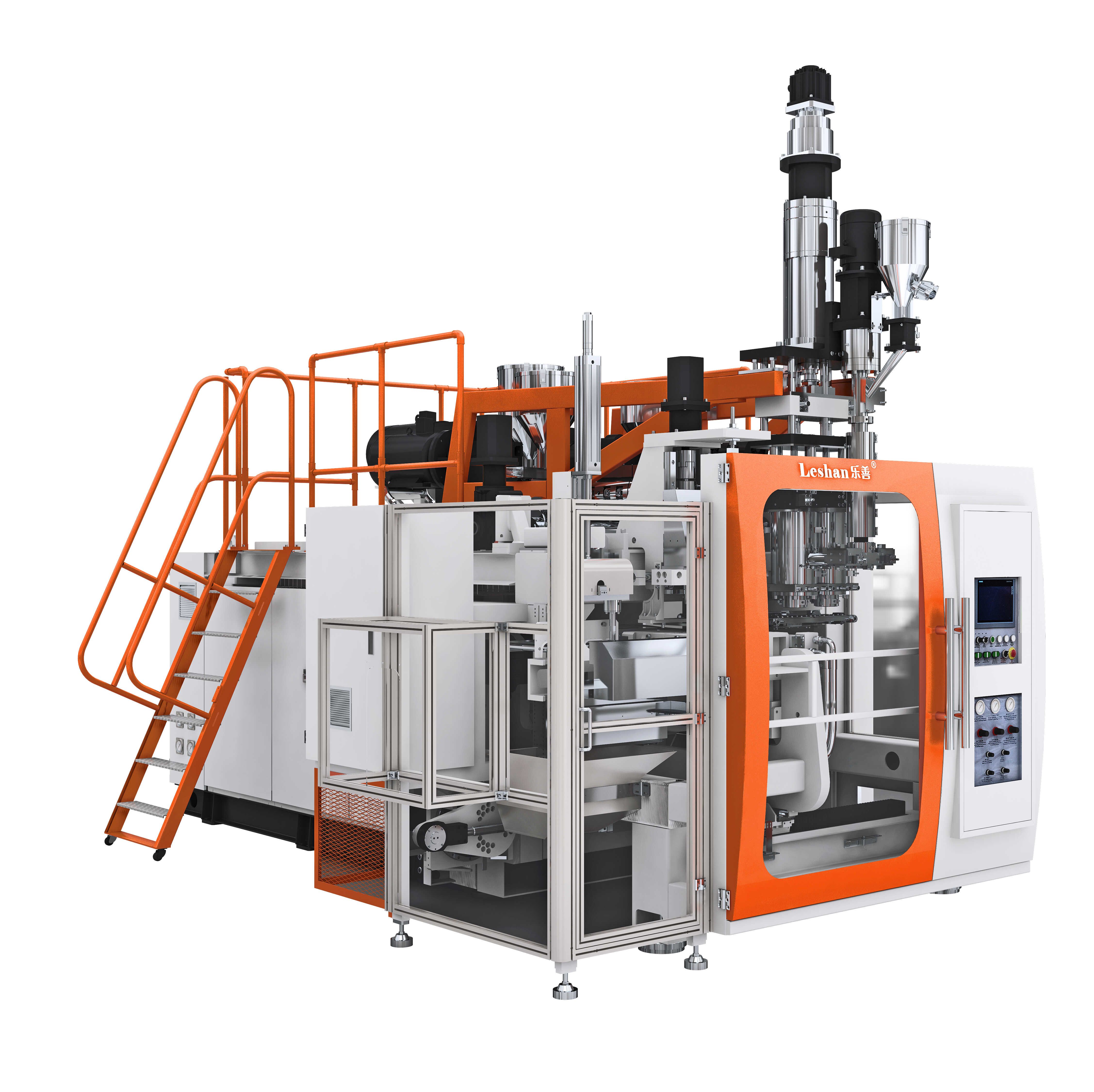
Chlorox Bottle Extrusion Blow Molding
Chlorox Bottle Extrusion Blow Molding
Guangdong Leshan Intelligent Equipment Corp.,Ltd was established in 1995. The company is one of the largest blow molding machine and high-precision mold manufacturers in China. The company has a group of experienced employees who have contributed more than 20 years in the blow molding machine industry and a team skilled in after-sales service. We produce equipment such as PET Machine,Blowing Mould & Injection Mould,Auxiliary machine,multi-layer coextrusion blow molding machine,athlon series hydraulic machine,Chemical barrel blow molding machine,Cleaning bottle blow molding machine,Food bottle blow molding machine,Engine oil bottle blow molding machine,Daily chemistry bottle blow molding machine,Irregular shape product blow molding machine. Used for producing various plastic products.
LESHAN has Numerical-controlled knee bend machine,Numerical-controlled cutting machine,Vertical CNC gantry machining-center,Four axis CNC machining-center and other specialized equipment.We have obtained ISO9001:2012 international quality management system certification and CE system certification. With a good reputation and excellent service, our products have achieved huge sales in the domestic market and more than 50 countries. With excellent reputation and excellent service, our machines have achieved huge sales.
| Parameter | Information |
|---|---|
| Product Name | chlorox bottle extrusion blow molding |
| Brand Name | Leshan |
| Place of Origin | Foshan,China |
| Plastic Processed | PVC,EVA,Polystyrene,ABS,PC,PP...etc |
| Air Pressure(MPa) | 0.8 MPa |
| Color | Customized Color |
| Delivery Time | 45 days |
| Port | ShunDe/GuangZhou/ShenZhen China |
| Export region | America,Oceania,Europe |
| Export Country | Russia, Australia, Poland,Trinidad and Tobago,Reunion,Tokelau,Tajikistan...etc |
| Application | Bottle |
| OEM/ODM | Acceptatble |
| Core Components | Engine,Pump,Motor,Bearing,Gearbox...etc |
| Voltage | 380V |
| Service | Field installation, commissioning and training... |
| MOQ | 1 set |
| Certification | ISO9001,CE... |
| Supply Ability | 500 Set/Sets per Month |
| Weight (T) | 5-18(According to specific model) |
| Packaging Details | Standard exporting machine packing with plastic film |
| Lead time (days) | 70 (To be negotiated) |
Please note: The above table data is for reference only. For specific information, please contact us.

chlorox bottle extrusion blow molding also offer flexibility and scalability. It can adjust the production process and parameters according to production needs to meet different product requirements. At the same time, the blow molding machine also has extension functions. By adding additional devices, it can realize bottle mouth separation, label attachment and other processing to meet the application needs of more fields.

chlorox bottle extrusion blow molding---FAQs Guide
2.How does the extrusion blow molding process differ from injection blow molding, and what types of products are typically produced using each method?
3.How long does it usually take to troubleshoot chlorox bottle extrusion blow molding?
4.What is the working principle of a blow molding machine?
5.What are the safety standards for chlorox bottle extrusion blow molding?
6.What are the key components of a chlorox bottle extrusion blow molding?
7.What are the precautions for operating a chlorox bottle extrusion blow molding?
8.What is the output of chlorox bottle extrusion blow molding?
1.How to prevent air leakage in chlorox bottle extrusion blow molding?
We should perform well in market competition, and the prices of chlorox bottle extrusion blow molding products have a great competitive advantage.
1. Regular Maintenance: Regular maintenance of the blow molding machine is essential to prevent air leakage. This includes checking and replacing worn out seals, gaskets, and other components that may contribute to air leakage.
2. Proper Lubrication: Lubrication of moving parts is important to ensure smooth operation of the machine and prevent air leakage. Make sure to use the recommended lubricants and follow the manufacturer's instructions for lubrication intervals.
3. Check Air Hoses and Fittings: Inspect the air hoses and fittings for any cracks, tears, or loose connections. Replace any damaged parts immediately to prevent air leakage.
4. Use High-Quality Components: Using high-quality components, such as valves, seals, and gaskets, can help prevent air leakage in the blow molding machine. These components are designed to withstand high pressures and are less likely to fail.
5. Adjust Air Pressure: Make sure to adjust the air pressure according to the manufacturer's recommendations. Too much or too little air pressure can cause air leakage in the machine.
6. Properly Align Parts: Misaligned parts can cause air leakage in the blow molding machine. Make sure all parts are properly aligned and tightened to prevent air from escaping.
7. Regularly Inspect the Machine: Regularly inspect the machine for any signs of air leakage, such as hissing sounds or drops in air pressure. If any issues are found, address them immediately to prevent further air leakage.
8. Train Operators: Properly trained operators can help prevent air leakage by operating the machine correctly and identifying any potential issues before they become major problems.
9. Use Air Leak Detection Systems: Consider using air leak detection systems to identify and locate any air leaks in the machine. This can help prevent air leakage and improve the overall efficiency of the machine.
10. Replace Worn Out Parts: Over time, parts of the blow molding machine may wear out and contribute to air leakage. It is important to regularly replace these parts to maintain the integrity of the machine and prevent air leakage.
2.How does the extrusion blow molding process differ from injection blow molding, and what types of products are typically produced using each method?
We have been working hard to improve service quality and meet customer needs.
Extrusion blow molding and injection blow molding are two different processes used to manufacture plastic products. While both methods involve melting plastic and shaping it into a desired form, there are some key differences between the two.
Extrusion blow molding is a process in which a molten tube of plastic, called a parison, is extruded through a die and then inflated to form a hollow product. The parison is then cooled and the mold opens to release the finished product. This process is commonly used to produce bottles, containers, and other hollow objects.
On the other hand, injection blow molding involves injecting molten plastic into a mold cavity, where it is then cooled and solidified. The mold then opens to release the finished product. This process is commonly used to produce small, complex, and precise products such as medical devices, pharmaceutical packaging, and small bottles.
One of the main differences between the two processes is the way the plastic is shaped. In extrusion blow molding, the plastic is shaped by the inflation of the parison, while in injection blow molding, the plastic is shaped by the mold cavity.
Another difference is the type of molds used. In extrusion blow molding, the molds are typically made of two halves that come together to form the desired shape. In injection blow molding, the molds are usually made of a single piece that is opened and closed to release the product.
The type of plastic used also differs between the two processes. Extrusion blow molding is typically used for high-density polyethylene (HDPE) and polyethylene terephthalate (PET) plastics, while injection blow molding is commonly used for polypropylene (PP) and polyethylene (PE) plastics.
In terms of product applications, extrusion blow molding is commonly used for larger, more simple products such as bottles and containers, while injection blow molding is used for smaller, more complex products such as medical devices and pharmaceutical packaging.
In summary, extrusion blow molding and injection blow molding are two different processes used to manufacture plastic products. While both methods involve melting plastic and shaping it into a desired form, they differ in the way the plastic is shaped, the type of molds used, and the types of products produced.
3.How long does it usually take to troubleshoot chlorox bottle extrusion blow molding?
Our mission is to provide customers with the best solutions for chlorox bottle extrusion blow molding.
The time it takes to troubleshoot a blow molding machine can vary depending on the specific issue and the experience of the technician. In some cases, it may only take a few minutes to identify and fix the problem, while in more complex cases it may take several hours or even days to fully troubleshoot and resolve the issue. It is important to thoroughly diagnose and address any problems with the machine to ensure it is functioning properly and producing high-quality products.
4.What is the working principle of a blow molding machine?
We focus on innovation and continuous improvement to maintain a competitive advantage.
The working principle of a blow molding machine involves the use of compressed air to inflate a molten plastic tube or parison inside a mold cavity. This creates a hollow shape that is then cooled and solidified to form a plastic product.
The process begins with the plastic material, usually in the form of pellets, being fed into a hopper and then melted in an extruder. The molten plastic is then forced into a long tube or parison, which is then clamped between two halves of a mold.
Next, a nozzle is inserted into the parison and compressed air is blown into it, causing the plastic to expand and take the shape of the mold cavity. The mold is cooled to solidify the plastic, and then the mold halves are separated, and the finished product is ejected.
The blow molding process can be either extrusion blow molding or injection blow molding, depending on the type of machine used. In extrusion blow molding, the parison is formed by extruding the molten plastic through a die, while in injection blow molding, the parison is formed by injecting the molten plastic into a mold cavity.
The working principle of a blow molding machine is based on the principles of thermodynamics and fluid mechanics, where the expansion of compressed air inside the parison creates pressure that forces the plastic to take the shape of the mold. This process allows for the production of hollow plastic products with complex shapes and sizes.
5.What are the safety standards for chlorox bottle extrusion blow molding?
We are a new chlorox bottle extrusion blow molding manufacturer.
1. Electrical Safety: Blow molding machines should comply with all relevant electrical safety standards, such as the National Electrical Code (NEC) and the International Electrotechnical Commission (IEC) standards.
2. Machine Guarding: All moving parts of the machine should be guarded to prevent accidental contact and injuries. The guards should be securely fixed and not easily removable.
3. Emergency Stop: The machine should have an easily accessible emergency stop button that can quickly shut down the machine in case of an emergency.
4. Lockout/Tagout: The machine should have a lockout/tagout system in place to prevent accidental start-up during maintenance or repair.
5. Pressure Relief: Blow molding machines use high-pressure air to mold plastic, so they should have a pressure relief system in place to prevent over-pressurization and potential explosions.
6. Material Handling: The machine should have a safe and efficient material handling system to prevent injuries and accidents during the loading and unloading of materials.
7. Noise Control: Blow molding machines can produce high levels of noise, so they should have noise control measures in place to protect workers' hearing.
8. Fire Safety: The machine should have fire safety measures in place, such as fire extinguishers and fire alarms, to prevent and control fires.
9. Operator Training: All operators should receive proper training on how to operate the machine safely and be aware of potential hazards.
10. Regular Maintenance: The machine should undergo regular maintenance and inspections to ensure it is in good working condition and meets all safety standards.

6.What are the key components of a chlorox bottle extrusion blow molding?
Our chlorox bottle extrusion blow molding products have competitive and differentiated advantages, and actively promote digital transformation and innovation.
1. Extruder: This is the main component of a blow molding machine, which melts and forms the plastic material into a parison (hollow tube).
2. Die Head: The die head is responsible for shaping the parison into the desired shape and size.
3. Clamping Unit: This unit holds the mold in place and provides the necessary pressure for the blowing process.
4. Blow Pin: The blow pin is used to inflate the parison and shape it against the mold.
5. Cooling System: After the parison is blown and formed into the desired shape, a cooling system is used to cool and solidify the plastic.
6. Ejection System: Once the plastic has cooled and solidified, the ejection system removes the finished product from the mold.
7. Control System: The control system is responsible for monitoring and controlling the various components of the machine, such as temperature, pressure, and speed.
8. Mold: The mold is a crucial component of a blow molding machine, as it determines the final shape and size of the product.
9. Hydraulic System: The hydraulic system provides the necessary power and pressure for the various movements and functions of the machine.
10. Electrical System: The electrical system supplies power to the machine and controls the various electrical components.
11. Safety Features: Blow molding machines are equipped with various safety features, such as emergency stop buttons, safety guards, and sensors, to ensure safe operation.
7.What are the precautions for operating a chlorox bottle extrusion blow molding?
We operate our chlorox bottle extrusion blow molding business with integrity and honesty.
1. Read the manual: Before operating the blow molding machine, it is important to thoroughly read and understand the manual provided by the manufacturer. This will help you understand the machine's capabilities, limitations, and safety precautions.
2. Wear appropriate protective gear: Always wear appropriate protective gear, such as safety glasses, gloves, and earplugs, when operating the blow molding machine. This will protect you from any potential hazards.
3. Keep the work area clean: Make sure the work area is clean and free of any debris or obstructions. This will prevent accidents and ensure smooth operation of the machine.
4. Check the machine before use: Before starting the machine, check for any loose or damaged parts. Make sure all the safety guards are in place and functioning properly.
5. Use the correct materials: Use only the materials recommended by the manufacturer for the blow molding machine. Using the wrong materials can damage the machine and pose a safety risk.
6. Follow proper loading procedures: When loading materials into the machine, make sure to follow the proper procedures outlined in the manual. This will ensure the materials are loaded correctly and prevent any accidents.
7. Do not touch moving parts: Never touch any moving parts of the machine while it is in operation. This includes the mold, extruder, and other moving components.
8. Keep hands and clothing away from the machine: Keep your hands and clothing away from the machine while it is in operation. Loose clothing or jewelry can get caught in the machine and cause serious injuries.
9. Do not leave the machine unattended: Always stay with the machine while it is in operation. If you need to leave the machine for any reason, make sure to turn it off and wait for it to come to a complete stop before leaving.
10. Shut down properly: When finished using the machine, shut it down properly following the manufacturer's instructions. This will help prevent any accidents and prolong the life of the machine.
8.What is the output of chlorox bottle extrusion blow molding?
We have a good reputation and image in the industry. The quality and price advantage of chlorox bottle extrusion blow molding products is an important factor in our hard overseas market.
The output of blow molding machines is plastic products, such as bottles, containers, and other hollow objects. The exact output will vary depending on the size and type of machine, as well as the production speed and efficiency.
Tags: quality blow molding machine
